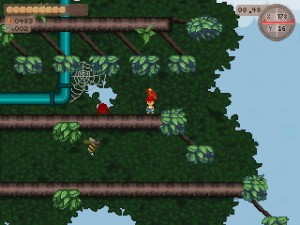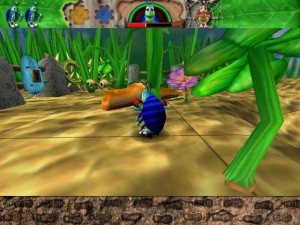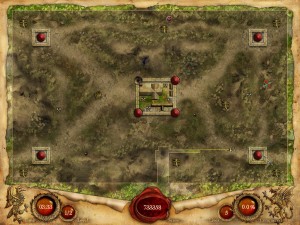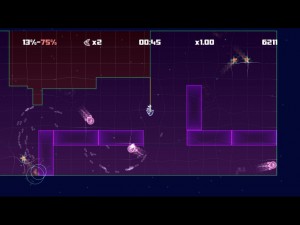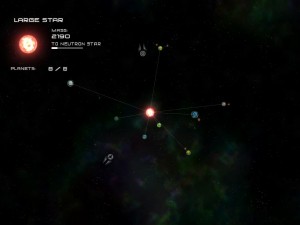Apollo 18+20
Twenty years ago this year, a band called They Might Be Giants released one of their better-regarded albums, Apollo 18. In celebration of this anniversary, Kevin Jackson-Mead organized a “tribute album” of short text adventures, one for each song, by various authors, including myself: I did “My Evil Twin”. The full package was released two weeks ago, and got mentioned on various major websites like rockpapershotgun and metafilter. This is about as good as publicity for IF gets these days, but, as one of the participants, I found the coverage unsatisfying, lacking commentary and analysis. Now that I’ve played all the games, mostly to successful conclusions, it’s time to redress that.
Now, if you’re familiar with the album, you might be wondering about Fingertips. Fingertips is the musical equivalent of WarioWare: a sequence of songs about ten seconds long each, with clashing styles and humorously enigmatic lyrics. Rather than simply presenting this as a medley that you listen to as a unit, the CD had each of the songs on a separate track, and encouraged the listener to play the entire album on shuffle — and I can report from personal experience that it’s even more effective to shuffle them into a larger and more varied music collection, so that, say, a Philip Glass composition or one of Satie’s piano pieces might be followed by John Flansburgh belting out “What’s That Blue Thing Doing Here?” and then falling silent.
Yes, each Fingertips song gets its own game. But to imitate the form of the songs, there was a rule that they had to end after only one move. This is a formal restriction that actually has some precedent in IF. Sam Barlow’s Aisle (1999) was the trailblazer, demonstrating the narrative possibilities of a single move, and Rematch, written by Andrew Pontious the following year, surprised everyone by showing that the same structure could make for an elaborate and deeply-implemented puzzle game. But that’s about as far as the experimentation went; in the decade-plus since Rematch, the only other one-move games I’ve seen have been a few joke items, mostly parodies of Aisle. That means that the 21 Fingertips games now form the majority of this sub-genre.
Mind you, some of them really strain the one-move descriptor. There are a couple that let you examine objects freely, only counting it as a move when you take an action that affects things. A lot of them rely on iteration — for example, the adaptation of the initial “Fingertips” (a song that consists of the word “Fingertips” repeated four times over a banjo accompaniement) uses a time-loop premise to excuse the fact that the player has to spend several turns examining objects, taking inventory, and so forth in order to figure out the one command that averts the destruction of the space station you’re on. Although each move is followed by a paragraph describing the station blowing up, it feels more like a single multi-turn playthrough. Mind you, Aisle and Rematch were also heavily based on iteration, but it somehow seems less right to expect the player to keep on entering commands for ten minutes when you’re adapting a ten-second song. And while some of the Fingertips games really are over after a single command, some of them took me longer to bring to a satisfactory conclusion than some of the non-Fingertips games in the collection.
Mind you, the one Fingertip that kept me occupied the longest, Who’s Knocking On the Wall, not only didn’t rely on iteration, it actively discouraged iteration: the whole thing is an elaborate randomly-generated logic puzzle, which gets re-randomized on each attempt, making all your reasoning worthless the moment you make a wrong guess. This is one of the more technically impressive works in the collection, despite its constraints and despite the narrow range of input it accepts.
As for the rest of the songs on the album, the game authors took a variety of approaches. Some attempted to base their story on the song, others took greater liberties, and one or two just launch into a puzzle environment with a vague connection to the song’s title. That last category definitely contains Turn Around, but I say “one or two” because Space Suit is a special case: based on an instrumental, it has no lyrics to adapt. But at least it presents a strange enough environment that you can easily imagine the song playing in the background, which is actually a fairly rare thing in these games — I know I personally didn’t make much effort to make my game fit the tune as well as the words. The Guitar (The Lion Sleeps Tonight) is of particular note in that it not only tells a story that unites the song’s nonsensical lyrics, it also imitates the song’s structure: just as the song alternates between two sections with different styles and different vocalists, the game shunts you back and forth between two player characters in different, but linked, situations. I Palindrome I, by noted palindromist Nick Montfort, links to its song solely through its form, ignoring its vague suggestion of a story about filial antagonism and menacing intergenerational patterns in favor of just palindroming it up.
The thing is, the vagueness of TMBG’s lyrics makes it difficult to say for sure in some cases what’s a result of disregarding the song and what’s a sincere difference of interpretation. Discussions with friends back in the day revealed disagreement about whether “Spider” was about a guy named Spider or a literal spider. The game takes the latter view, but also makes spiders the villains rather than the hero, which is something that hadn’t even occurred to me: the line “Spider!” followed by “He is our hero” seemed pretty clear, but the whole song is a collage of samples, so I can see how someone else would consider the two lines completely disconnected. Narrow Your Eyes strikes me as pretty far from the spirit of the song, which is about a disintegrating relationship, much like such other TMBG songs as “They’ll Need a Crane” and “I’ve Got a Match”. The game instead has the PC racing to a wedding rehearsal, the only obstacle being a supervillain who gets in his way. The thing is, despite this drastic shift of tone, the game does take care to imitate superficial details from the lyrics (where it provides details to imitate), which raises the possibility that the author simply didn’t see the song the same way I did (although lines like “Our love’s never coming back” make me doubt that). It’s certainly in the spirit of other TMBG songs.
In one case, I have to admit that my own view of the song is probably the weird and atypical one: I’ve never really seen the experience described in “The Statue Got Me High” as a bad one. Sure, it talks about being killed and set on fire, but it also talks about being dissatisfied with human company afterward, which makes the whole dying-and-burning thing seem metaphorical. And this is the sort of metaphor used in describing mystical or religious experiences. This is the same album that contains “See the Constellation”, which describes looking at the stars and having a vision of being the stars looking at yourself on the ground below (an idea disappointingly ignored by its more prosaic game adaptation); a song about experiencing a personal transformation on looking at a work of art would not be out of place here. Mind you, the final stanza about the fire engine and the charred and smoking chair kind of goes against this interpretation. At any rate, the game adaptation takes the death and the burning literally. But I can’t complain about the result, which is to my mind the most brilliant use of the medium in the entire collection. Essentially, the game gives you a situation with no apparent connection to the title, with a clear goal, a puzzle and clues to focus your mind on. And then, just when you have enough information to start making progress, the statue renders it all irrelevant. This is very much in the spirit of the song even in my weird interpretation: whatever it is you think is really going on in those lyrics, the narrator’s encounter with the statue changes everything for him.
I suppose one of the biggest challenges for the authors was coming up with goals and motivations. Even when TMBG’s songs aren’t outright nonsensical, they’re usually more descriptive than narrative. “Dinner Bell” and “Mammal” consist largely of lists of things, and so both were adapted into treasure-hunts; the strange part is that in both cases the authors motivate it by adding on a premise involving oppression by animals, something that wasn’t a factor in the songs at all. “She’s Actual Size” is basically just words of idiosyncratic praise for an unnamed woman, and I’m still not entirely sure what’s supposed to be going on in the game.
I speak of the vagueness, the nonsense, and the lack of obvious goals in the lyrics as challenges for the authors, and this may have given you the impression that some other album, from a different band, would have made a better basis for such a project. But from a player’s point of view, these attributes are strengths. They make for a greater variability than adaptations from a more narrative source would, and that leaves the player guessing wondering what on earth the game version of, for example, “Which Describes How You’re Feeling All The Time” will be like. (It turns out to be a fast-paced word game.) It also has me inevitably thinking about how I would have adapted the same songs. I think the only game that’s more or less the same as my imagined version is Fingertips: I Don’t Understand You, because the joke there is kind of inevitable in an IF context. I already had specific plans for If I Wasn’t Shy and Fingertips: I Walk Along Darkened Corridors from before they were claimed by other participants, but it was only after playing Fingertips: What’s That Blue Thing Doing Here? and seeing how far it was from my expectations that I realized I had expectations for it, and consequently clarified those expectations in my mind to something like a design. I almost feel like I want the whole project to be run again so I can get some of my ideas into more concrete form.
Ah, but that would take away from the time to work on genuinely new projects. Better to tackle a different album. Anyone up for Flood?
 Comments(6)
Comments(6)